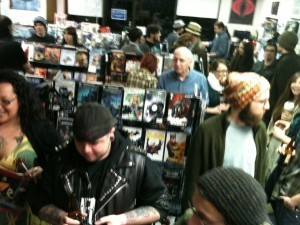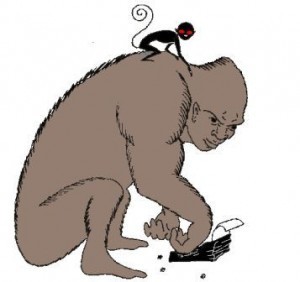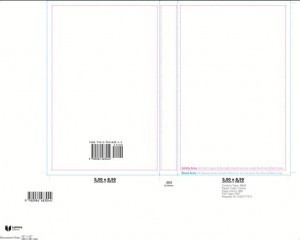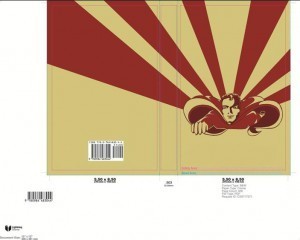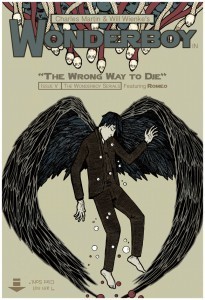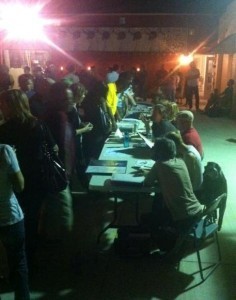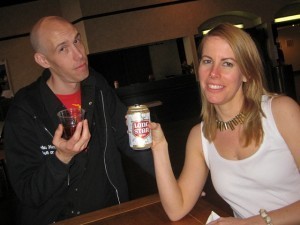Charles Martin's Blog, page 51
January 2, 2012
Release of The Wonderboy Serials: Season One print anthology!
The Season One print anthology will be hitting bookstores, pop culture conventions and the interwebs in January! Only $14 and it includes Issues One through Six. The official release party will be 11 am to 5 pm on Saturday, February 25 at New World Comics at 6219 North Meridian in OKC as part of the Oklahoma Comic Creators Live Art event.
Ask for it at your local bookstore, pick it up at a convention, or go online to Amazon or click the button below to obtain directly through Literati Press via Paypal!

2012 is shaping up
For our complete schedule, visit our booking agency's website at Skiptheopeningact.com!
Edmond Author's Book Fair
January 14, 2012
1:00 pm
to
4:00 pm
Edmond Historical Society & Museum at 431 S. Boulevard!
SFX Sci-Fi Expo
February 11, 2012 4:00 pm
to
February 12, 2012 4:00 pm
The Irving Convention Center in Texas!
Mini A-Kon
February 18, 2012
10:00 am
to
5:00 pm
Free side event to the massive anime convention! Check out Dusk, Literati and Shonuff!
North Branch Library
3020 N. Locust St.
Denton TX,
Oklahoma Comic Creators Live Art Event
February 25, 2012
11:00 am
to
5:00 pm
At New World Comics at 6219 North Meridian Avenue in Oklahoma City. This will be the official launch of the print anthology of The Wonderboy Serials and will be going from 11 am to 5 pm.
Staple! 2012
March 3, 2012 6:00 pm
to
March 4, 2012 6:00 pm
Marchesa Hall & Theater in Austin.
Chicago Comic And Entertainment Expo
April 13, 2012
to
April 15, 2012
Denver Comic Con
June 15, 2012
to
June 17, 2012
January 1, 2012
Book fairs and signings and cons, Oh My!
Fans love them, writers and artists need them. The problem with promotional events? No one wants to actually organize them.
Unlike musicians and artists, there aren't dedicated venues for people to go see living, breathing creators of books and comics. Instead, a small handful of people must take it upon themselves to create and promote free-standing events to draw in readers that would otherwise never know about the wealth of incredible stuff going on under the radar of the pop culture mainstream.
If you are one of the brave few that is willing to invest the time and money to get one of these events off the ground, here is my advice on how to successfully organize a small scale promotional event.
A little background on me: I have organized dozens of signings, two events with the Oklahoma Comic Creators and three book fairs. I have also worked with larger art happenings in various capacities, so have picked up several dos and don'ts.
Number One Rule: Know what you are trying to accomplish and be realistic with your goals! Do you want a massive convention or do you want a smaller live art event with a handful of invited guests? Knowing what you are shooting for and knowing how to accomplish it will save you money, time, and great deals of frustration. Sure, I may want to organize a book fair with hundreds of writers and thousands of attendees, but that would be unrealistic given my limited time and funds(not to mention finite interest in the reading community.) Trying to develop a large scale book fair in one year is a great way to break your heart and empty your bank account, so start small and know your limitations. A small event with a dozen creators and two hundred attendees is way more fun than an over-sized event with double the attendance, but half the sales.
Number Two Rule: Don't make money the wrong way! No one gets rich off book fairs and only the biggest convention have paid staffers. It would be nice if there were sponsors out there willing to back the costs of a worthwhile event, but it is incredibly hard to find anyone willing to donate money. It would also be nice if a small book fair could raise money through a door charge, but that would guarantee low attendance. It is tempting to hike up booth costs to cover your expenses, but if you are a writer who sells only five books at $10 a piece and you paid $60 on your booth for an event that only drew a couple hundred people, you will never go back to the event.
Instead, just know that you will lose money on the event and the goal is just to lose as little as possible. If the event grows and your reputation strengthens among fans and creators, then other revenue streams like sponsorship and ad sales will prevent themselves.
Number Three Rule: Don't underestimate the power of the internet and social networking! I started out hanging dozens of posters and handing out thousands of fliers for my book fairs. I shifted instead towards online marketing through Facebook and other networks and encouraged my participating creators to help spread the word. I still hang posters and print up some fliers, but instead lean on the digital realm to stoke interest. If you develop a reputation as a fair, honest, and hard-working promoter, then word of mouth will create more foot traffic than thousands of dollars worth of advertising and handbills.
Number Four Rule………….Timing! Check the dates of conventions all around your region and especially in your state. Look for festivals, large-scale art and music events. If you are in a college town, check the football schedule. Holidays might work in your favor, but could also doom you. There is something happening every weekend of the year in any decent-sized city, but some weekends are better than others. Summers are especially tough since conventions pack the months from May to September, so maybe look at late fall through mid-spring instead.
Number Five Rule: Know your audience. This was my problem with my first few book fairs. I wanted it to be general interest, but this made it hard for me to penetrate specific markets. I shifted to sci-fi/horror fiction and comics, which meant I had to exclude a lot of writers I respected, but made it easier for me to market the event to specific audiences.
Number Six Rule: Attract talent. Instead of booth rentals, I have shifted to an invite-only method. This means I lose money on every event and lack the funds to grow much larger than a small indie fair, but I'm okay with that. When you are charging for booths, you are stuck with whoever pays. No matter how much time you've spent on decoration, despite your wonderfully clever event title, or how slick your poster image came out, if the vendors are amateurish and their merch is cheap, then your event will look cheap.
Number Seven Rule: Location! Always look for existing foot traffic. Book stores are great for small signings, but few can accommodate anything much bigger. There are tons of empty buildings or galleries where you can get space for the right price, but that doesn't mean you will ever get people to make the drive. My most successful events have always been in locations where I know where there will be guaranteed crowds, like art walks or galleries during existing art exhibitions. You will have to settle for smaller spaces with higher fees, but you will actually save money because you won't have to worry as much about promotion. Plus, a well-synergized event will boost your reputation and draw in attendees that you would otherwise never have access to.
Number Eight Rule: Treat Your Volunteers Right! Good volunteers are your most valuable commodity. Don't complain, take advantage of them and make sure they know they are appreciated.
Number Nine Rule: Schmooze! Creative talent can be insufferable divas, but if they feel like you are listening and respecting their gripes, they'll be valuable for word of mouth advertising down the road. Also, good schmoozing helps create a positive atmosphere among the attendees and the talent, which loosens wallets. Loose wallets make for happy talent and happy talent makes for sustainable events.If you only have twenty artists, but they all bring in twenty fans each, that's 420 people at your event which means success.
Number Ten Rule: Self-Sufficiency! This is the most important rule of all. Do not pay for anything you can do yourself(aside from printing fliers/posters.) Whatever venue you book, load in your own stuff and clean up after yourself. Do not make yourself a pain to the venue owner or you will not be invited back. If you ask someone to do you a favor, acknowledge that there is a good chance they will forget or screw it up. If it's important enough that you would be pissed if they drop the ball, then do it your damn self.
Finally, have fun! You can't control the weather, you can't control how many people actually show. Promote to the best of your ability, stamp down fires as they arise, but know that so much is outside of your influence that you might as well not worry and just enjoy whatever may come. Creators are so hungry for places to promote that they will, for the most part, be understanding when the unforeseen happens, when the crowds don't flock like you thought they would, or a few details are overlooked here and there. The fans will also appreciate having another free event to check out their favorite local and regional talent. As long as you gave it your best shot and treat everyone honestly, they will come back next year…hopefully with all their friends!
December 29, 2011
Goddammit, you bitch! You never backed away from anything in your life! Now write!
Or…
How to know when it's time to give up.
Writing a novel is a tremendous leap of faith. No matter how thoroughly a writer has outlined, no matter how many times the story arch has echoed in their mind, there is no way to know if the novel will actually work until the story unfolds on the page. The plight of any novelist who actually gives a damn about his/her craft is the very real possibility that a year or more invested into one book can be squandered once the story derails. Sometimes the it can be saved, sometimes it can't. It is better to walk away from a failed endeavor than to push it out on the public, so here's how I've discerned which of my previous projects to stick with and which to abandon.
Firstly, I've completed ten novels in my life. I've published two(three if you count The Wonderboy Serials) and plan on publishing two more. The rest are entombed in a file cabinet in my garage where they will stay for the remainder of my life until my family(desperate to capitalize on my fabulous fame) publishes them all postmortem as the "Lost Classics of Charles Martin & Will Weinke". On top of those finished not-quite-masterpieces, are dozens of aborted ideas.
By the time I finished the rough draft or was simply staring at a blank screen halfway in, I lost the passion for the project necessary to push the book through to the end. Sometimes the story came off as insincere, sometimes there were inconsistent or illogical elements to the plotline I couldn't reconcile. More often than not, I just realized the book wasn't going to meet my own standards and didn't want it released to the general public.
Reaching this moment isn't necessarily a death sentence. Two of my completed books(one of them being "the dominant hand") started off as a similar idea that just didn't work. Instead of walking away entirely, I started over from scratch and tweaked the idea enough so I found an element I could really be excited about. In the case of "the dominant hand", it was meant to be more of an ode to a friend of mine who was in a coma. It became too brutal and I had a hard time putting the needs of the story above the emotional needs. In the other case, I switched perspectives and changed my goals on where I wanted the story to end up, both in the arch and in the theme. The result in both cases were stronger novels that I could be proud of.
I'll often do the same trick to individual scenes. Rather than trying to salvage a piece of crap chapter, I'll toss it completely and write from memory. This is almost always effective at infecting vitality and finding small elements of the story that I could embellish that were muted or lost entirely in the first attempt. This approach is a pain in the butt, but if you wanted simple, go work fast food.
Very often, there will be no saving a flawed story and repeated attempts to breath life back into the project is just a waste of time and hope. I'm a big believer that your first few novels are just practice. If you finish, be proud you saw it to the end. If you didn't, dissect what went right and what went wrong so you learn for the next project. If you have a book that you just have to finish and grace the world with its brilliance, don't write it first. Hold onto the idea and refine your craft first. Plus, a little extra living will add perspective to the story.
There is also the old adage of a writer writes everyday. The more your write, the better you become, but I don't think it is wise to apply this practice to a novel. Every writer works differently, but for me, I only write on a novel when I'm ready. I spend more time staring into space, trying to untangle the chaos of a fresh idea until I feel it is sorted and ready to be brought into the world. It's impossible to know how long this process will take, so don't rush it. I'm currently on day three of trying to sort out the first scene of the last issue of The Wonderboy Serials. I am so desperate to get this series wrapped up that it's making me sick, but I have to wait until the scene is ready to be written. If I don't, I risk letting the story wander off in the wrong direction and the writing to come off as flat and lifeless.
So, instead, I'm writing a blog post to keep my hands busy while the rest of me is still digging into the scene and trying to find that lost element that will bring the whole thing together.
To wrap up, there is no way to prevent a project from derailing. Sometimes ideas are fatally flawed and you won't know until you've gotten deep into the rough draft. That is okay. It is incredibly frustrating and it will break your heart to give up on the project, but it's what you must do if you care about your craft. If you've developed Stephen King fame where your fans will forgive your every misstep, you might have more leeway, but that isn't necessarily a good thing. It is our failed experiments that mature us. Writers have the very unique opportunity to continue progressing throughout our lives, don't waste it by trying to beat life back into every doomed story. Instead, learn, adapt and push that energy to the few ideas that are destined for great things.
December 21, 2011
Creating your cover
You've developed a sparkling personality, put together a wicked booth, and tracked down the best cons you can reach with your limited travel budget. Now you need a great cover to seal the deal.
There is no shame in paying someone to design the cover for you, but there is a good chance you'll still have to assemble the final product for print. Graphic design majors can do this in their sleep, but writers might not be quite as comfortable, so here's a brief overview of how to do it. Every printer will work a little differently, but I will be showing you the process of creating a cover for Lightning Source, who we are using to put out season one of The Wonderboy Serials.
First off, ensure that you are working in CMYK versus RGB. RGB is often the default and is used for images that will only be viewed from a computer screen. CMYK is standard for commercial printing.
Second, ensure that you are leaving sufficient bleed for your project. Bleed is basically an extra quarter inch on all sides that gives the printer room for error. This is a little more complex for a novel because you have the spine to consider when designing the project. Check out the image below for the guidelines Lightning Source gave me for my project.
This template was designed for my specific page count using an engine on their site. What I like about this template is it gives you clear bleed lines. If you have Photoshop, or a similar editing program, you can delete the white space so the image becomes transparent. You can then lay your cover image under the lines, making the process fairly idiot proof. If you are using Publisher, which I have in the past and it worked fine, you just need to watch your rulers closely.
Also, even though the bleed lines are clear, refrain from moving your logos, or text too close to the edge. It will make the cover look crowded.
IF YOU PURCHASE YOUR OWN ISBN NUMBERS, DO NOT PAY FOR BAR CODES! As you can see, the bar code was already placed for me. Most printers can create a bar code for you for free and there are programs online that will allow you to do it yourself. The first time I bought an ISBN, I chipped in the extra $50 for a bar code and it didn't even work, so just get the ISBN number and let your printer create the bar code for you.
Here is the cover image placed.
Notice that the beams extend out to the edges beyond the bleed lines. I don't mind losing that part of the image and I also want to make sure that no white space will show if there is a deviation in where the paper is cut. I also dig having the image wrap around the spine, but even if you don't, make sure that the spine doesn't clash with what's happening on the front and back. For the anthology, I took the original Issue One cover design by Karen Martin and extended the beams out to the back. I also gave myself plenty of room on the top and bottom of Wonderboy to put on the necessary info. For good cover images, ere on the side of simplicity. A single, striking image will do more to sell a book than a lush and complex cover.
What I believe needs to be on every cover is:
FRONT: Reputable review quote(media or notable author, not your mom)SMALL, Title BIG, Author(s) MEDIUM.
BACK: Description(not too long, not too short, just detailed enough to grab the reader's attention), publisher logo(if you are self-published, create your own small press and throw the logo on there), price, website, bar code. Some people will throw more quotes on the back, but it can look cluttered if you aren't careful. I also tacked on the Wonderboy logo for balance.
SPINE: Title, author name, publisher logo.
Once you are done, check your printer's preferences. Some will want a .jpeg, some will want a .pdf, some might want the original Photoshop document so they can tweek as needed. Also, make sure you are saving it as a high resolution image. Jpeg and TIF will give you the option of saving at 300 dpi or 150 dpi. If you save at 150, the print image will look pixilated and cheap. Also, don't use a compressed image on your cover. Check the file size if you aren't sure. If it's a 72 kb image you pulled off your Facebook page, it will look gross once it's printed.
Finally, be prepared to make changes when the printer sends it back to you. I have sent several projects to the printer and still get them shot back to me for making stupid mistakes like not centering the text, not embedding fonts and, sigh, forgetting to take the guidelines off the finished product. It happens. Just stick in there and know that once the cover is done and looks stellar, it will do a lot of the heavy lifting by drawing customer interest to your table.
Here is the final product of the season one anthology of The Wonderboy Serials.
Good luck!
December 12, 2011
Issue Five
"The Wrong Way to Die" is out now and will be steadily popping up at eBook retailers over the next couple weeks. It is currently available at Amazon and at Smashwords. Cover by Buddy D. Oswald at Bombs Away Art. Only 99 pennies!
December 11, 2011
Shove Thy Neighbor: A Guide to Peacefully Co-Existing at Cons
They're loud. They're rude. They ramble on about things you don't care about, they spill over onto your space and they drive away the people who stop to talk to you.
And you can't get away from them.
They're the guys at the booth next to you.
In actuality, most artists and vendors at Cons are not Those Guys. Most of the people you'll be seated next to are respectful, thoughtful and interesting people much like yourself. The douches and dudebros we refer to as Those Guys are few and far between, but spending just one Con seated next to them can suddenly make it seem like they're everywhere.
Here are a few tips to ensure good relations with your fellow Con-Goers.
1) Arrive Early. Get there in plenty of time to set up your table before things get started. Not only does this head off any Israeli-Palestinian border disputes (if you're not sure where your space ends and theirs begins, you've got plenty of time to flag down a volunteer and ask before things get busy), but it puts you in a better headspace. Running late makes you cranky, which will be apparent to your neighbors and anyone else who encounters you. Being early leaves you relaxed and prepared. It also gives you a chance to see who'll be setting up next to you, so you know what to expect.
2) Start out on a good foot. Introduce yourself to the people around you. Shake hands, chat, ask them about themselves and their product. Putting yourself out there in a friendly and engaging manner predisposes people to like you, and gives your relationship with your neighbors the best shot at being congenial. Also, if any of them are socially clueless, self-absorbed monologuers prone to going on and on and on about things no one cares about, better to find out now while you still have the handy escape excuse of "Oh, looks like the doors are opening. Better get back to my booth."
For almost every Con, Rules #1 and 2 are all you need. Most neighbors will be nice guys and you will get along swimmingly. Not only are you watching each others' tables, but you're all going out for beer and pizza together after the doors close.
But on the off chance that one of your neighbors is in fact, Those Guys, here's how to cope.
3) Let the Little Things Go. Yes, your neighbor's full-sized banner display is tacky and borderline offensive, and they insist on going on and on about why Wes Crusher was an underrated character. If it's annoying but innocuous, let it go. Flagging down Con personnel to complain about petty grievances that they can't really help only makes you look like the difficult one, and might affect your reputation and your ability to get in next year.
4) Laugh it Off. Yet another reason it's a great idea to team up at these events. The guy who insists on speaking only in Naavii is insufferable when you're stuck on your own, with only your murderous thoughts to keep you company. Companionship functions as a release valve. Having someone else to roll your eyes with takes that guy from Supreme Irritant to Comedy Gold.
But what if Those Guys can't be ridiculed or ignored? Their loud house music or obnoxiously aggressive sales pitches or graphic displays of underage Japanese tentacle monster porn art are driving Con-goers away like AAA on New Year's Eve. It's affecting your bottom line and your blood pressure.
5) Address the Situation. Nicely. If you've waited until you're mad as hell and you're not gonna take it anymore, you've already lost. Remember how we told you to introduce yourself earlier? Well, now you have a pre-existing relationship with them, so you can walk over, complement them on… well… something. Anything. Start off on a positive foot ("Nice attention to detail on those Tentacle Monster scales!"), and then politely point out the issue. Frame it as something they were unaware of, because they're nice people with the best of intentions, and you merely want to bring this small misunderstanding to their attention. If you can frame the issue as a correctable oversight that will benefit everyone, them included, once it has been addressed, you stand the best chance of making positive headway without damaging relationships.
6) Escalate as a Last Resort, and for the Good of Everyone. You've tried all of the above, and failed. Your polite request that Those Guys not crank their Swedish death metal/techno remix of the Super Mario Brothers theme up to 11 has been met with scorn, and they've actually become more obnoxious. One of Those Guys is now taking off his pants and clipping his toenails, and the other one is shouting offensive things at random people walking by. When you've given Those Guys a chance to correct the issue, and the offending behavior is causing people to leave the area, or even the Con, it is time to address the issue with the Con organizers. Con organizers put a lot of time and effort into planning and organizing, and they want to ensure a successful event, and a good reputation for the Con as a whole. Bring the issue to them with the same polite "I thought you should know about this" tone that you used to try and resolve the situation in step #5. Cons are busy, hectic places, and the people running them have no way of knowing what's going on everywhere, all the time. You may need to put in some work to try and locate the Con person with the authority to address the situation, but don't give up until you've given the Con every chance to make things right.
The good news is that Steps #5 and 6 are rarely necessary. The odds are good that you'll go your entire career without needing to resort to them. But like condoms and nuclear missiles, it's good to know that they're available to you. Just in case.
December 5, 2011
Style > Substance
(Karen Martin is taking over blog duties this week!)
So you've gotten your book or comic published, your table reserved, and now all you need to do is get to the Con, right?
Not quite.
People can't look at you and discern your gift for words, your ability to craft a story arc, to show the nuances of your deeply conflicted hero in a single panel drawing. They just see you. Which is why your appearance is your first marketing tool.
1. Your Booth. Sit with someone else, if you can. Being the single guy sitting by yourself at a table drives people away in droves. The Mysterious Loner may be romantic, but he doesn't move paper at Cons. Bring your writing partner or your inker or your girlfriend (more on that in a moment). Better yet, team up with another local artist and share a table. More than one person at a table not only looks more professional, but it puts con-goers at ease.
2. Neatness Counts. A cluttered table doesn't say "cornucopia," it says "yard sale." Banners and posters are good, because they add height to your display, but don't pour all your money into a banner and sit at a bare table. Your booth should reflect the tone of your product: whether it's horror, sci-fi, steampunk, retro, or what have you.
Don't be afraid to try something a little unusual or off-beat in your table display – people remember what stands out. Rather than being the millionth guy with a horror comic and a resin skull sitting on a black tablecloth, go the extra mile. People will notice and be drawn to the slaughter-house themed table with a "blood" spattered table cloth, a cow skull, posters hanging from meat hooks, and the artists wearing butcher's aprons.
3. Personal appearance is important! Going to a con wearing a t-shirt and sweatpants may be comfortable, but it's boring at best, and at worst, makes you look like the creepy guy that goes to strip clubs on a Tuesday afternoon.
Your clothes and appearance sell you as an artist or author, and that sells your product. Charles likes to wear a themed bowling shirt that mirrors the tone of our booth when we're at Cons, but he's also been known to wear a white suit and fedora for a 'Satan as Southern Dandy' effect when promoting Edward and the Island. You can put together some cool and unusual outfits without breaking the bank by frequenting thrift stores and keeping your product in mind. Somebody, somewhere, has donated the perfect velvet jacket to wear when promoting your steampunk novel, or the perfect black undertaker's suit for your creepy graveyard comic.
4. Eye Candy. So, you've got your tweed pressed and your best vest, all you really need is the girl.
Any female presence, whether it's an author, artist, or booth babe, helps. People are more likely to approach a booth with a woman there. Use this to your advantage. Tie your female writer, artist, or booth babe's appearance into what you're promoting. Your female artist or author should be wearing the t-shirt with your comic on it. Ditto your hot girlfriend. And if you can persuade her to dress up as one of your characters to promote your booth, then you should seriously consider marrying her.
Like the dating scene, most customers decide within the first thirty seconds whether they are interested, so you want to make an impression. Don't be afraid to take a chance, to stand out, even to have a few fails when crafting your appearance. After all, a ground-breaking comic that nobody notices is still just another stack of paper you have to haul home at the end of a convention.
November 29, 2011
Lean, Mean, Touring Machine
Authors aren't rock stars touching down in cities across the globe to teaming masses of frenzied fans. Comic book artists aren't going to be rolling across the highways in decked out tour buses with champagne-filled hot tubs. We are all poor, so when we travel, we must travel smart. The Literati Press war chest is far from impressive, but it still gets us down the road pretty far, stretching from coast to coast as we try to dig our claws into new markets. Here are a few tips on how to live the touring life on the cheap:
1. CARPOOL: This is the single most effective way to travel. Split gas, hotel, and food costs with fellow creatives in order to get more mileage out of your promotion budget. Don't just travel with anyone, though. Travel with people you like and trust. You can also split booth costs this way, but compared to hotel stays and skyrocketing gas costs, opting for a second $100 table isn't that big a deal.
2. MAKE FRIENDS IN EVERY TOWN: Talk to your fellow vendors and make nice. They can give you inside scoops on hotel deals or, if you're really lucky, offer up a couch next time you're in town. Again, only do this with people you trust and be the perfect house guest wherever you crash. Clean up after yourself, offer to cook for the host and don't be a dick.
3. DON'T EAT OUT: We might get one meal at a hip, local restaurant on each trip, but that's it. We have a rolling cooler that we take into the conventions which is packed with fruits and vegetables, sandwiches, granola bars, B vitamin supplements for energy, water, and flavor packets we can mix into the water bottles. When we run out of food, we find the nearest grocery store and restock. What excess money we do have, we try to use at the convention to buy stuff from other vendors. This supports your fellow creatives, exposes you to some cool new titles, but it also aids in making nice with the locals which could save you money in the long run.
4. MAKE SURE YOU HAVE SOMEWHERE TO SLEEP EVERY NIGHT: Traveling on the cheap takes dedication, but it can be taken too far. Unless you have a Winnebago, don't sleep in your car. Also don't sleep on the convention floor. Always have a bed or comfortable couch to sleep on because, in the end, living like a homeless person will just lead to burnout. Rooms can be found in most cities for $50 or less and it is worthwhile investment. I've done the sleeping in airports thing and its not worth it. If you sleep at all, you wake up miserable, smell awful, feel awful and have limited your ability to charm potential fans.
5. NETWORK: This is actually still a weak spot for me, but I've seen it done successfully. Rather than hitting the town after the day's over, stay in the hotel and attend room parties. Talk to convention volunteers, talk to fellow vendors and talk to attendees. Tons of valuable info can be mined from these conversations that will lead you to make better decisions on which conventions to attend in the future.
6. BE SELECTIVE: Research your conventions on the internet and fellow vendors. If it is a new event, be cautious. Don't avoid new cons entirely, though. If you were throwing a convention $100 for a booth when it started, then when it blows up four years later and booth costs have tripled, they will sometimes cut you a break for your loyalty.
7. VOLUNTEER: You want a free table and to get onto panels. This is how. Nothing's free in this world. This is also good for the soul.
8. DISTILL: Don't take everything in your garage to every convention. You want your booth to look nice, but you need to be able to transport your entire load in one trip. If you are carpooling, you won't have tons of room, so take only what you absolutely need. Literati Press packs two large plastic tubs, fry baskets, a small wooden sign and its holder. All this fits onto one dolly, so, if I'm on my own, I can pull that and my cooler back and forth to the convention with minimal effort. I'll have just enough clothes to get me through the weekend and toiletries to keep me so fresh and so clean.
9. CONSIDER GPS: Either through your phone or a separate device, GPS tracking can save you gas and mountains of frustration. I toured without it before, and never want to go back to that miserable existence.
10. AVOID ISOLATION: Nothing sucks more than sitting out a ten hour shift for three straight days at a convention all on your own. Take a friend, split a booth, whatever you can to get help. Getting up and stretching your legs from time to time is super helpful and keeps your mind crisp when dealing with attendees.
11. TOUR ON DISPOSABLE INCOME: Don't go into debt to travel and don't dip into your grocery funds. The money you are spending on travel should be money that you don't really need. I carry an extra job whose primary purpose is to fund our touring expenses. Book and art sales sometimes recover all expenses, but that's not something you can count on and its much better to direct that money toward printing more or paying your talent. This also helps alleviate desperation when you attend a convention where no one is buying. If you don't need the money to get the gas to get home, then you can just enjoy the convention as it is, a chance to make initial contact with future buyers.
12. DON'T BE THAT GUY: You know the one, your book got a good review from your buddy's blog, so now you think you can demand the attention of an A-list celebrity. These vendors are at every convention, small fry authors and artists that bitch about every little shortcoming of a convention because they've got 2,000 friends on Facebook, which means they are important. Conventions are hard to run, mistakes will be made, just be nice about it and don't bitch to (or about) the volunteers. If they ask for your input, be constructive and DO NOT BE A DICK. Convention organizers talk to one another, so if you gain a reputation as a problem vendor, then you'll never be asked to be a guest.
Touring is a hard, expensive endeavor, but if you are smart, it can be fun and rewarding. Just keep hope and remember that the vast majority of successful writers and artists started out just like you, a trunk packed with product and a head stuffed with ideas.
November 21, 2011
Get Off Facebook And Get Back To Work!
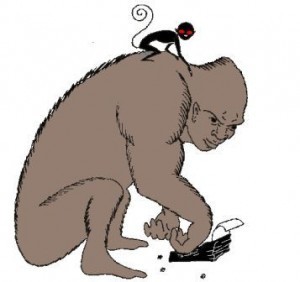 At its roots, writing is just another industry. We are producing a tangible item which, if it has value, it will sell. It if doesn't, then it will whither on bookstore shelves. Those wanting to cobble together a career within the industry need to commit to their projects with the same devotion and sense of purpose that a lawyer would invest into a case or a doctor would for a patient. Every project, whether a writing a novel or scripting a comic, will help define your legacy. Writers who treat their projects with the casual disregard of a hobby will be equally dismissed by the reading public.
At its roots, writing is just another industry. We are producing a tangible item which, if it has value, it will sell. It if doesn't, then it will whither on bookstore shelves. Those wanting to cobble together a career within the industry need to commit to their projects with the same devotion and sense of purpose that a lawyer would invest into a case or a doctor would for a patient. Every project, whether a writing a novel or scripting a comic, will help define your legacy. Writers who treat their projects with the casual disregard of a hobby will be equally dismissed by the reading public.
A common mantra among many novelists is "write everyday". I don't ascribe to this as inherently necessary. Only a portion of the creative process actually involves pecking away at a keyboard and it is important to know when it is time to let the story simmer and when it is time to write. Writing too soon can kill a project as easily as waiting too long, so what follows is the breakdown of my own creative process I've used to conceive and finish eight novels, dozens of short stories, and countless other small projects. It can be broken down like this:
1. Idea Generation. I never write anything down during this step, rather it is the forging process in my mind as I attempt to sculpt the tentative story arch, characters, tone, and purpose of the story. Purpose is the most critical element of the Idea Generation step, and this is not the same as the theme. It is why you, on an emotional level, want to write the book. What purpose does it serve you and what are you trying to say. If you do not have a truly compelling reason for writing a book, then when the story inevitably bogs down, you will not be committed enough to fight through the frustration to pull the story back out of the muck.
2. Character Development. I never write this down, but I know that some people do, which is okay. I prefer to fully form my characters before I put anything to paper. The characters provide the emotional weight of any story, and if they are not believable and engaging, then your story will fail no matter how great the concept. For instance, Star Wars IV, V, and VI succeeded but I, II, and III were wretched misfires because of the success/failure of George Lucas to provide a quality ensemble cast. A critic, whose name is lost to me, said that a good test of a poorly written character is whether you can easily describe them without mentioning race, religion, clothes or other surface details. Han Solo = roguish, clever, self-possessed, charming, deceptively noble. Queen Amidala = ???
3. Concept Development. Again, I never write this down, but many do. The concept is the first thing created, in my experience, but the concept will continue to shift and bend throughout the creation process as the needs of the story change. The concept cannot be broken, though, because doing so will betray the trust of the reader. Be true to your purpose, be true to your characters, and be true to your concept. Everything else is negotiable.
4. Outlining. Here is where writers should begin actually writing. I do not do rich outlining, but rather put a word or two down for each chapter as a placeholder that will, if needed, jog my memory later on. If you are doing a series of comics or, like my Wonderboy dime novels, a serialized work, outlines are no less critical because they keep your project from derailing as you go from one issue to the next. Some writers will begin writing without an ending in mind, just taking the project one page at a time. I doubt anything substantial has ever come out of this method and, in my opinion, is best reserved for the private journals of moody teenagers.
5. Rough Draft. Repeat steps 1-4 throughout while writing the rough draft to keep yourself on track, but also giving yourself the flexibility to shift organically with the natural pace of the story. Your novel/comic is a living thing and it has needs that may not match up with what you originally wanted from the book. No scene should ever be so important to you that you cannot cut it for the good of the entire book. If you suspect a scene should be cut, then it almost certainly needs to be cut since, as the writer, you are naturally protective of everything you produce.
6. Break. After the rough draft is done. Give yourself a couple weeks or even a month or two while you work on another project. Maybe something easy and fun to take your mind away from the previous project. When you return, you should have fresher eyes.
7. Editing. The most important step in the process for writers wanting to push their project on the general public. I also enjoy this step immensely since it really is not that hard. Finding typos and reworking entire sections of a book is a time-consuming challenge, but not as spiritually exhausting as birthing the rough draft. Editing doesn't leave me spent and I can, quite literally, do it all day without wearing myself down as much as two hours of rough draft writing. If you can't learn to enjoy this process, then perhaps you should look into another career.
8. More Editing. One mantra I do agree with is a writer never finishes a book, they merely give up. Any creative project will never be perfect because it is a living thing. The flaws will always be there, but you have to decide which flaws you are willing to live with because what you fix in one part of the book could weaken several other parts. In fact, it is the flaws that give your book character, just as the flaws of a person are a big part of what makes them a human.
9. Even More Editing. Like I said, every book will help define your career, so be sure the book is as ready as it can be before the first stranger gets their hands on it. My novels are edited countless times by me and other paid/volunteer readers. Give yourself breaks in-between each pass through the book so you are less likely to miss the same mistake. Also, when you have the final draft, do one more pass while READING IT OUT LOUD. I emphasize this because I thought it was a stupid when my mother first suggested it, and like so many other things she told me, she was irritatingly correct. If you can't comfortably say a line out loud, then it won't read well either. You are so familiar with the book that your eyes can skip over clunky sentences, but your mouth can't.
10. All The Other Crap. Blurbs, cover design, layout, press releases, promotion and all that other stuff is just as important to creating the actual project, but I'm not going to go into that stuff here since it has/will be covered in my other blogs. Needless to say, you are not done when you have submitted your final draft to the publisher/printer and a great book with poor follow-through is doomed.
So, to stay busy as a writer does not mean to write every day, but you should be working on your projects with the same determination as an architect steadily tweaking the plans for months before the foundation is even poured. My process is unique to me, so its okay if your way is a little different so as long as you are always producing in some way.
When generating an idea, I will spend weeks doing little more than staring at walls while my mind churns. It is hard to explain to your spouse how you are working hard when there is no written proof, but you are and if they are really invested in your career, they will at least pretend to believe you.


